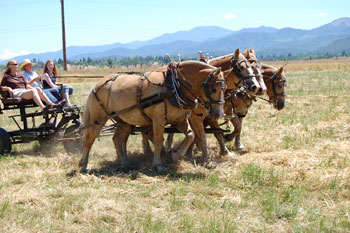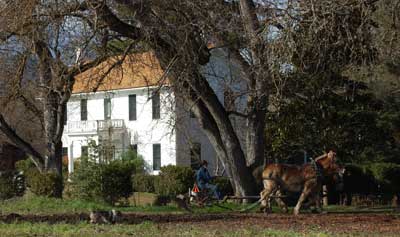 Were you able to visit the farm July 9 and watch the draft horses as they drove the equipment to disk the field? After mowing earlier in the month, the field needed to be disked; that is, the cover crop needed to be plowed back into the ground to replenish the soil. This is the task those beautiful horses performed. If you weren’t able to see them this time, don’t despair. August 4, 5 & 6 are Harvest days at the farm, and the horses will be back to thresh and bind the wheat.
Were you able to visit the farm July 9 and watch the draft horses as they drove the equipment to disk the field? After mowing earlier in the month, the field needed to be disked; that is, the cover crop needed to be plowed back into the ground to replenish the soil. This is the task those beautiful horses performed. If you weren’t able to see them this time, don’t despair. August 4, 5 & 6 are Harvest days at the farm, and the horses will be back to thresh and bind the wheat.
The horses gracing our fields in July and August are owned by members of the Hanley Historical Farming Committee, and the teams working on the 9th consisted of one team of Belgians, and two teams of Warmbloods. Now, what is a Warmblood? you may ask. I know I did! First, however, a little about the Belgians who worked our field, and will be returning in August. Ron Martison, farming committee member and horse-owner, estimated that his Belgian draft horses are 17 hands tall (approximately 5.8 feet, the horses’ height up to their shoulders) and weigh about 1,950 pounds. As I perused the Internet, I learned that the Belgian draft horse was once known as the “Black Horse of Flanders,” and had settled in the “…European low country, what is now Belgian and Northern France.
The other two teams are Warmbloods, a crossbreed of the draft horse and a standard, or “saddle horse,” breed. They are 16 hands (about 5.4 feet) tall, and weigh approximately 1500 pounds. Historically, the large, heavy “cold blood” war horses of northern Europe were bred with the lighter, faster Mongolian “hot bloods,” creating a combination of the agility of the race horse, and the large build and mild temperament of the cold blood. Over time, European draft horses were bred with hot-blooded imports, the “…forerunners of dozens of breeds in existence today.” As horse use grew to include more farm work, horses had to be strong, yet remain stylish enough for carriage use and for riding. So, while the Warmbloods may be smaller and more “stylish” than the draft horse, these beauties certainly hold their own on the field!
August is another eventful month at Hanley Farm! Friday evenings, 4pm-7pm, and Saturdays & Sundays, 11am to 3pm, the farm is open for picnics and self-guided tours.
Harvest Days at the farm – August 4, 5 and 6! August 4 and 5 are “equipment set-up” days. Binder set-up is on the 4th, and threshing equipment on the 5th. Come and watch the equipment set-up, and please feel free to ask questions! Saturday, August 6, weather permitting, the wheat will be threshed using the draft horses and horse-drawn equipment. (Due to inclement weather, when writing this article, the wheat hadn’t matured. Hopefully, all will be well on the 6th!)
August 6, the final day of our harvest celebration, is Food Preservation Day. The event features over a dozen demonstrations and workshops on food preservation – cheese making, vegetable fermentation, smoking meat, drying fruit, vegetables and herbs, homemade jams, etc. Kid Time will be hosting a number of children’s activities, including wheat grinding, butter making, apple peeling, and much more. For the first time, you will be able to purchase wheat just as it comes out of the field!
Draft horses will be harvesting the wheat crop (weather permitting) and wheat berries will be sold directly from the field. Wheat berries will be sold in 10, 25 and 50 pound sacks.
If you find yourself overrun with tomatoes and zucchini, join us for a day of experiential learning about the many different methods of food preservation, from modern day freezing to canning methods that have not changed in over 100 years.
With help from experts from the Oregon State University Agricultural Extension Service, visitors can learn how to make herbal vinegars and mustards; cheese; and herbal extracts and tinctures; and how to can jellies; smoke meat; dry fruits, vegetables and herbs; and make cheese. Kirsten Shockey of Mellonia Farm will be teaching how to make krauts and pickles.
The event will feature exhibit booths with demonstrators and seven twenty-minute workshops on the above topics. Hands-on demonstrations will be supplemented with opportunities for tasting and lots of printed information for at-home preservation. For a full schedule of events, visit www.sohs.org/hanley_farm.html
Hanley Farm is located at 1053 Hanley Road, between Central Point and Jacksonville. Hours are 11am-3pm. Admission is $5 for adults, $3 for seniors aged 65 and over, and children, 3 to 12 years of age. Admission is free for SOHS members.
For more information about Hanley Farm or upcoming events, call us at 541-773-2675; e-mail us at hanleyfarm@sohs.org; visit on-line at www.sohs.org/hanley_farm.html; or check out our Hanley Farm Facebook page!

